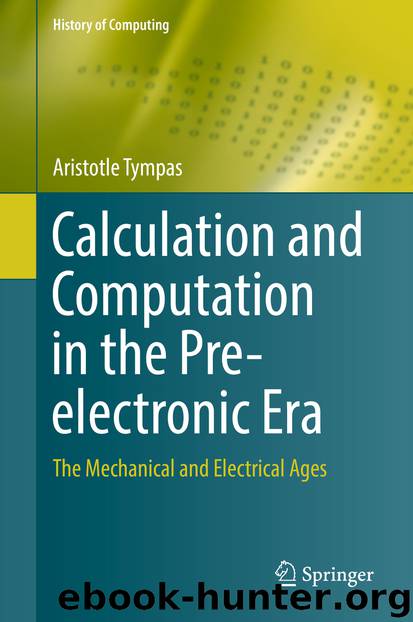Calculation and Computation in the Pre-electronic Era by Aristotle Tympas

Author:Aristotle Tympas
Language: eng
Format: epub
Publisher: Springer London, London
5.2 “A Perfect Poem: The Most Lovely Exposition of Mathematics in Simple Form”
The leadership of General Electric ’s Charles Proteus Steinmetz and Harvard-MIT’s Arthur Edwin Kennelly during the first generation of electrical engineering was founded on their mastery of the calculation technology developed and used to rehearse the rapid lengthening and interconnection of electric power transmission lines. They were both pioneers in the introduction of calculating methods and artifacts for analysts , from the appropriation of imaginary numbers to electrical engineering calculations to analyzers that exemplify the mechanization of these calculations. The first calculating board came out of Steinmetz ’s General Electric Department; Kennelly was the protagonist in the development of the tradition of artificial lines for electric power calculations, which set the stage for the network analyzer of the following generation—led by Vannevar Bush, his dissertation advisee (Chap. 4). Both Steinmetz and Kennelly were actually experts in the full range of the calculating technology that was used to launch the electrical era. In this section, I will rely on their views regarding artifacts that come from the other end of the spectrum of calculating technology , the least mechanical: calculating tables and graphs.1
In his influential textbook on engineering mathematics, Steinmetz devoted a long discussion to the issue of “intelligibility” of numerical calculations. It was focused on how to advance from plotting the carefully arranged values of tables to a curve or a series of curves. He considered this “necessary, since for most engineers the plotted curve gives a much better conception of the shape and the variation of a quantity than numerical tables.”2 On the other hand, he argued that “for recording numerical values, and deriving numerical values from it, the plotted curve is inferior to the table due to the limited accuracy possible in a plotted curve, and the further inaccuracy resulting when drawing a curve through the plotted calculated points.” Curves and numbers were feeding on each other. “To some extent,” explained Steinmetz , “the numerical values as taken from the plotted curve, depend on the particular kind of curve rule used in plotting the curve.”3
The point that I want to introduce to concerns the interdependence and the complementary use of the table and the graph , the two artifacts that are the focus of this chapter. The curve was a graph produced by plotting empirical data. Throughout his textbook, Steinmetz made it clear that it was the “empirical” curve that gave the “rational” or “empirical” equation from which the table was produced. In practice, the curve and the table—lines and numbers, we would now say the analog and the digital—were used complementary. They were also used along with the slide rule and other calculating artifacts, not against them. For example, in addition to curves, tables, and slide rules, in his chapter on numerical calculations , Steinmetz also mentioned semilogarithmic and logarithmic paper. “Such paper,” he advised, “was to be used in instances when the values of a relationship extended over such a wide range as to
Download
This site does not store any files on its server. We only index and link to content provided by other sites. Please contact the content providers to delete copyright contents if any and email us, we'll remove relevant links or contents immediately.
The Soul of a New Machine by Tracy Kidder(628)
Computer by Martin Campbell-Kelly; William Aspray; Nathan Ensmenger; Jeffrey R. Yost(628)
Darwin Among the Machines by George B. Dyson(391)
Hackers heroes of the computer revolution by Steven Levy(380)
Plain Text by Dennis Tenen(368)
The Story of the Computer by Marshall Stephen(359)
A Brief History of Computing by Gerard O'Regan(355)
Great Moments in Computing by Mel Croucher & Robin Evans(354)
Fire in the Valley by Paul Freiberger & Michael Swaine(345)
Reckoning with Matter: Calculating Machines, Innovation, and Thinking about Thinking from Pascal to Babbage by Jones Matthew L(338)
The New Digital Age: Reshaping the Future of People, Nations and Business by Schmidt Eric & Cohen Jared(325)
Between Human and Machine: Feedback, Control, and Computing before Cybernetics (Johns Hopkins Studies in the History of Technology) by Mindell David A(322)
Colossus by Paul Gannon(291)
Computing: A Business History by Lars Nielsen(210)
Calculation and Computation in the Pre-electronic Era by Aristotle Tympas(186)
